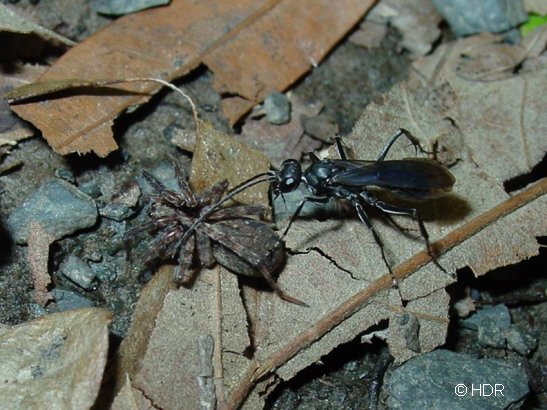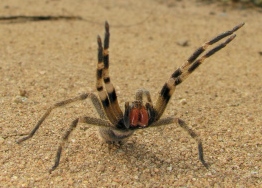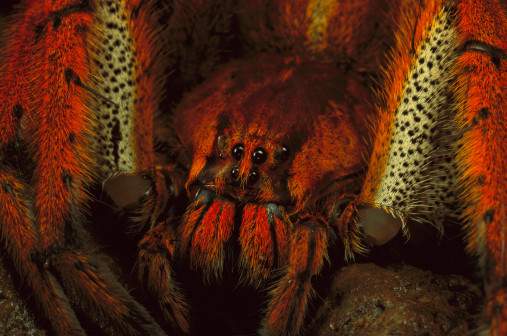Ecology & Interactions
Predators of
P. fera
The Brazilian Wandering Spiders are all
ferocious predators and have only a few true predators. These
predators are called Tatrantula Hawks (pictured below) which refers to the
genus
Pepsis. These organisms are wasps that are normally
non-aggressive and tend to not attack any organisms other
than spiders. The female wasps will seek out their prey, in this
case P. fera, and will sting their prey, temporarily paralyzing
it. The wasp will then lay an egg in the spider’s abdomen and
drag the spider to a pre-made burrow. The spider will not die
from the venom of the wasp but rather from the hatched wasp
eating away the spider’s abdomen. Now there are other organisms
that will kill the spider but will usually be because of a
random struggle between the spider and large rodents, birds, or
a human that manages not to get bit.
organisms other
than spiders. The female wasps will seek out their prey, in this
case P. fera, and will sting their prey, temporarily paralyzing
it. The wasp will then lay an egg in the spider’s abdomen and
drag the spider to a pre-made burrow. The spider will not die
from the venom of the wasp but rather from the hatched wasp
eating away the spider’s abdomen. Now there are other organisms
that will kill the spider but will usually be because of a
random struggle between the spider and large rodents, birds, or
a human that manages not to get bit.
Prey of P.
fera
 As for the prey of this spider, it can be almost anything.
This spider will eat crickets, large insects, mice/other
small mammals, lizards, or anything else they can find crawling
along the rainforest floor that isn’t too big for them to kill.
The younger spiders that are not yet large enough to eat some of
the bigger organisms as its parents, will usually just feed
on flightless fruit flies and pinhead crickets. The Brazilian
Wandering Spider is different than other spiders in that it will
actively search out their prey other than just spinning a web
and waiting for prey to fall in; this is where their name is
derived from, the fact that they will just wander their
environment looking for prey. Once they find their prey they
will use their superior speed and size to catch the organism,
inject its venom, and then eat the organism.
As for the prey of this spider, it can be almost anything.
This spider will eat crickets, large insects, mice/other
small mammals, lizards, or anything else they can find crawling
along the rainforest floor that isn’t too big for them to kill.
The younger spiders that are not yet large enough to eat some of
the bigger organisms as its parents, will usually just feed
on flightless fruit flies and pinhead crickets. The Brazilian
Wandering Spider is different than other spiders in that it will
actively search out their prey other than just spinning a web
and waiting for prey to fall in; this is where their name is
derived from, the fact that they will just wander their
environment looking for prey. Once they find their prey they
will use their superior speed and size to catch the organism,
inject its venom, and then eat the organism.
P. fera
and humans
P. fera and humans have a very close relationship with one
another in a variety of different ways. Because of their
wandering nature, P. fera will often wander away from their
normal rural environment and into the city where people are.
These organisms actually will get scared when they make their
way into the city, causing them to hide in confined dark places
such as clothes, shoes, crates, or the crooks and crannies of a
house or building. The majority of encounters between humans and
this spider are caused by humans accidentally coming across a
spider hidden somewhere in their home, at the market, or even in
the streets. Bites by the P. fera rarely cause human death
because of the fact that the spider will rarely inject a full
amount of venom if any
 at all when acting in defense. However if
a full amount of venom is injected it can cause death if an
anti-venom cannot be reached. Although these spiders can be very
dangerous to humans, the venom of these spiders is believed to
have a great medical importance and is currently being
researched. When males are attacked by this spider they will
often get hour long and usually painful erections, also known as priapism. A team of Brazilian and American scientists found that
one of the toxins in the venom, PnTx2-6, has been found to
improve erectile function in aged rats. This happens because the
venom boosts the amount of available nitric oxide which is a
chemical that dilates blood vessels and increases blood flow.
More information about the venom of this spider can be found in
the physiology page.
at all when acting in defense. However if
a full amount of venom is injected it can cause death if an
anti-venom cannot be reached. Although these spiders can be very
dangerous to humans, the venom of these spiders is believed to
have a great medical importance and is currently being
researched. When males are attacked by this spider they will
often get hour long and usually painful erections, also known as priapism. A team of Brazilian and American scientists found that
one of the toxins in the venom, PnTx2-6, has been found to
improve erectile function in aged rats. This happens because the
venom boosts the amount of available nitric oxide which is a
chemical that dilates blood vessels and increases blood flow.
More information about the venom of this spider can be found in
the physiology page.
Click here to proceed to
the Physiology page



